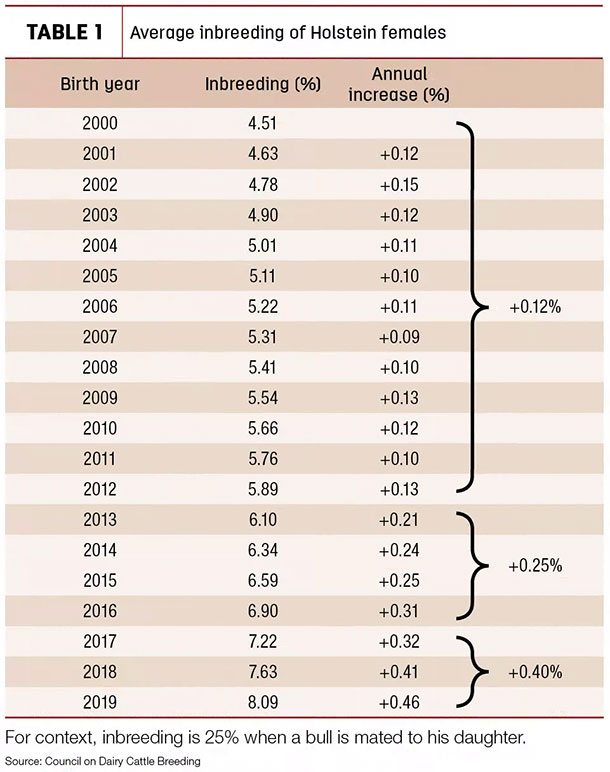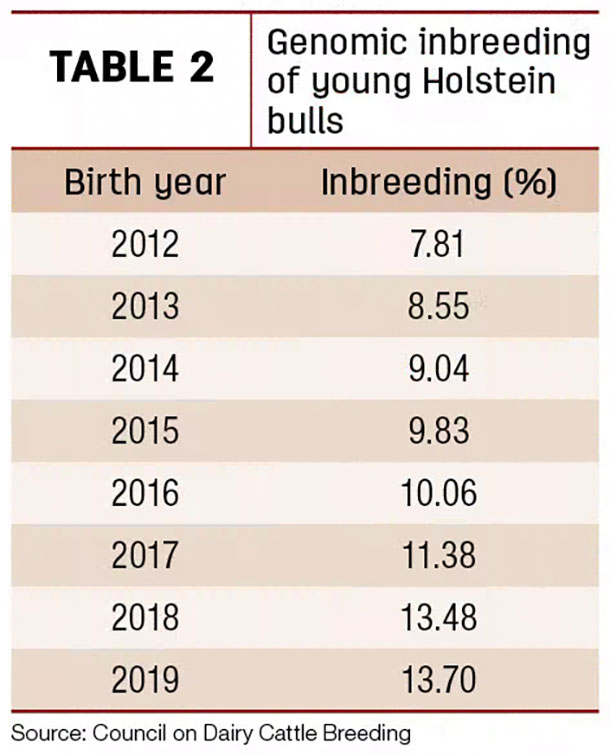Most traits for most breeds made genetic improvement since the previous genetic base change five years ago, and that means the PTA of all males and females will drop by the amount of genetic improvement over the five-year period. For the Holstein breed, the genetic base change will be about $231 for the Net Merit index, which combines economically important traits of dairy cattle into a single value. The $231 genetic base change in 2020 compares to the previous genetic base change in 2015 of $184 for the Net Merit index.
Information from CDCB points out the positive influence of genomic selection, which was introduced in the U.S. in 2008, on the acceleration of genetic improvement of dairy cattle. The new 2020 genetic base is centered on the performance of Holstein females born in 2015, and the previous 2015 genetic base was centered on Holsteins born in 2010.
Therefore, the 2015 base change from five years ago was influenced very little by genomic selection, but the 2020 genetic base change was heavily influenced by genomic selection. Acceleration of genetic improvement is good in many ways. However, are there potential negative consequences of accelerated genetic improvement? Unfortunately, yes, there is a major downside that many wish to avoid discussing – especially people who market dairy cattle genetics.
Virtually all of the accelerated genetic gain from genomic selection over our previous reliance on progeny testing (the actual performance of daughters) is due to a dramatic reduction in generation interval. Generation interval is the average age of parents when their offspring are born. The allure of genomic selection is choosing parents of the next generation at a very young age.
However, a major pitfall of reduced generation interval is a corresponding increase of genetic relationships within a population. This means a smaller number of genetically related and high-ranking males and females are permitted to be the ancestors of subsequent generations. As individuals in a breed become more related, the average inbreeding of a breed increases at an accelerated rate. Yes, it’s possible to reduce the acceleration of increased genetic relationships and, therefore, average inbreeding by placing limitations on the influence of individual males and females. However, has that been done with the global Holstein breed? Emphatically, no. We are “breeding the best to the best as fast as we can,” at a faster rate than any time in history.
Renowned dairy cattle geneticist Dr. Ben McDaniel spoke on the topic of “Uncontrolled Inbreeding” at the 2000 annual meeting of the American Dairy Science Association, and the proceedings of that presentation are published in the Journal of Dairy Science. I wish my friends who today represent the member organizations of the Council of Dairy Cattle Breeding, who are genetic researchers at the U.S. land-grant universities and who are leadership geneticists with the major dairy breeding companies would take the time to read that article from 20 years ago. I believe if Dr. McDaniel was still alive today, he would be aghast at the rapid accumulation of genetic relationships (and inevitable increase of average inbreeding) that has occurred in the global Holstein population over just the past five years.
Table 1 has the average inbreeding of U.S. Holstein females by birth year.

From 2000 to 2012, the average annual increase of inbreeding was +0.12%, which was regarded as a reasonable annual increase. At least some increase in average inbreeding is inevitable within a finite population (a breed). Genomic selection was initiated in 2008, and its impact on average inbreeding took a few years to kick in. However, the annual increases in average inbreeding rose to +0.25% for the four years of 2013 to 2016 (a doubling of the annual increase) and, amazingly, to +0.4% for the past three years. These recent annual increases are breathtaking and seem to be unsustainable into the future.
Average inbreeding of Holstein females born during earlier portions of 2019 (data isn’t yet complete) was already 8.09%. That number may seem small to some. However, it’s important to keep in mind that the upper limit for inbreeding isn’t 100%. The mating of a bull to his own daughter results in average inbreeding of 25% for the offspring.
For commercial livestock production, the long-term recommendation has been that inbreeding shouldn’t surpass 6.25%. The 6.25% isn’t a magical number, but it has been used across time as a goalpost for when the major negative consequences of inbreeding – early embryotic loss (reduced fertility), increased stillbirth, sterility and reduced health of animals of all ages – are most likely to start being felt.
Some have suggested we shouldn’t be concerned about average inbreeding of Holsteins until it reaches 10%. Well, current trends suggest the U.S. Holstein breed will reach that threshold in about four years. Then what? Once a breed has greatly reduced the number of key ancestors in pedigrees, it becomes impossible to broaden genetic variety at the gene level without relying on gene migration from an outside population (another breed).
Perhaps a more dramatic way to grasp what has occurred with the variety of ancestors contributing to Holsteins is to review the average inbreeding of young Holstein bulls since the start of genomic selection. Table 2 provides the average genomic inbreeding of young Holstein bulls.

These youngsters represent the genetic composition of the Holstein breed for the future. Young genomic bulls are heavily used by dairy producers and have become highly inbred over the past few years.
Bulls born in 2019 have average genomic inbreeding of 13.7%. High inbreeding of an individual bull isn’t a practical problem because bulls aren’t expected to produce large amounts of milk like cows. However, the average inbreeding of these young bulls represents the extreme “narrowing of the gene pool” of the Holstein breed. When these young bulls are mated to a typical Holstein female, some of the resulting embryos have extraordinarily high inbreeding.
So what does the genetic composition of the Holstein breed look like in 2020? It’s composed overwhelmingly of genes from only five high-impact bulls. Those five bulls are listed in Table 3.

For those familiar with registered Holsteins, these bulls will be very familiar. Unquestionably, their genomes contain genes that result in traits (production, function and conformation) that have been highly sought by dairy producers. However, limiting the future of the Holstein breed to such a small group of highest-impact bulls is unwise from a long-term perspective for breed improvement.
Table 3 also provides the average genomic future inbreeding for each of the five bulls. This inbreeding is what is expected if the bull would be mated to a typical Holstein female today. These extremely high estimates of inbreeding are simply a reflection of the huge impact of these five genetic giants of the breed on current Holsteins. Of course, these five bulls are already related to each other because their pedigrees, in turn, contain a multitude of ties to the high-impact bulls of the past like Elevation, Chief, Blackstar and Aerostar.
I have many former students and friends who are breeders of registered Holsteins, and they express major concern for the rapid increase of average inbreeding of Holsteins and the “narrowing of the gene pool.” Their intuition is correct: Average inbreeding is becoming too high. Genomic selection has been applied blindly by “breeding the best to the best as fast as we can” without regard to pedigree diversity. Why is that the case?
The dairy breeding companies dictate the genetics that are provided to dairy producers for commercial milk production. Why are the breeding companies so fixated on “breeding the best to the best as fast as they can” with almost no regard for pedigree diversity? The reason is simple: It’s survival of the company. Genomic selection has brought on an unrelenting desire and expectation for companies to make available bulls with highest-ranking genomic evaluations.
Competitive forces dictate highest PTAs of bulls to avoid being swallowed up by competitors. The survival of breeding companies (market share) is the overriding reason for the “uncontrolled inbreeding” the Holstein breed is experiencing at this time. Are the breeding companies conspiring to rapidly increase average inbreeding of Holstein females? Of course not. However, their goal for intense selection to maximize short-term genetic improvement may have major negative consequences in regard to the potential for long-term genetic improvement and viability of the Holstein breed.
Some may suggest the answer is to look to Holstein populations outside North America. Unfortunately, that would be of little help. Dairy cattle genetics is fully a global activity at this time. Holstein genetics from anywhere in the world are almost completely from the same gene pool. Outcross Holstein genetics with high genetic merit is nonexistent.
Without greater concern for the increases in inbreeding, deterioration of economically important traits, especially those related to health and fertility, is inevitable at the farm level. Research has documented that slowing down the average annual increase of inbreeding into the future can be accomplished with a minimal reduction in genetic progress by limiting the number of young bulls that are sons of individual sires and limiting the number of young bulls from specific cow families (the major Red dairy cattle breeds of Europe are doing this). However, to date, no meaningful effort has been exerted to do this sort of thing for Holsteins by the dairy breeding companies in the era of genomic selection. ![]()
Les Hansen has a Ph.D. in animal breeding and is a researcher and teacher of dairy cattle genetics at the University of Minnesota. Email Les Hansen.






